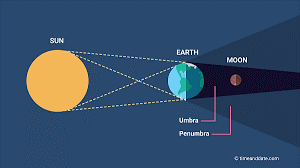Description

Disclaimer: Copyright infringement not intended.
Context
- A Lunar Eclipse (Chandra Grahan) will be occurring on October 28, which will be visible across many parts of the world, including India.
About
What is Lunar Eclipse?
- A lunar eclipse (Chandra Grahan) is an astronomical event in which the Moon darkens as it passes into the Earth's shadow.
- The event normally happens during the full moon phase, when the Moon's orbital plane is closest to the Earth's orbital plane.
- Occurrence: Lunar eclipses are a rather common occurrence, with approximately three lunar eclipses (Chandra Grahan) occurring each year.
- On average, a total lunar eclipse occurs once every 2.5 years.
Shadow
- The umbra (shadow): The dark center of the Earth's shadow is known as the Umbra.
- The Penumbra: The Penumbra is the Earth's outermost shadow.
- Mechanism of Occurrence: The phenomena happen when the Earth passes between the Sun and the Moon.
- Earth throws a shadow on the Moon's surface during this time, making it less visible.
Types of Lunar Eclipse
- Total Lunar Eclipse (Chandra Grahan): During this event, the Moon moves into the inner section of Earth's shadow or the umbra. Some sunlight weakly travels through the Earth's atmosphere and illuminates the Moon's surface.
- Partial Lunar Eclipse (Chandra Grahan): Because the Sun, Earth, and Moon are not perfectly aligned, only a portion of the Earth's umbra falls on the Moon. This shadow rises and falls, never entirely covering the Moon's surface.
- Penumbral Eclipse: The Moon passes through the Earth's penumbra, or the light outer section of its shadow, during a penumbral eclipse. The Moon's fading is so subtle that it can be overlooked.

The Scientific Explanation Behind the Lunar Eclipse
Why Does a Total Lunar Eclipse Cause the Moon to Turn Red (Chandra Grahan)?
- When the Moon enters the umbra or the inner part of Earth's shadow. Some sunlight weakly travels through the Earth's atmosphere and illuminates the Moon's surface.
- During this event, the Moon appears reddish. Because of the Rayleigh scattering of blue light, the moon appears reddish.
- The redder the Moon appears, the higher the dust or clouds in the Earth's atmosphere during the occurrence.
Effects of Lunar Eclipse (Chandra Grahan):
- Tidal Effect: Tidal impacts on Earth are greatest during full moons and lunar eclipses because the Sun and Moon are in line with Earth.
- Wildlife Behavior: Studies have shown that during a moon eclipse, animals behave differently. An owl monkey study revealed a significant change in activity during a lunar eclipse (Chandra Grahan).
- Cultural Belief: Lunar eclipses were thought to be a terrible omen by ancient human cultures. During this event, they engaged in human and animal sacrifice.
The Scientific Significance of Lunar Eclipses
Scientific Significance
- Shape of Earth: Earth’s shadow projected on the Moon allowed ancient people to deduce that Earth was spherical.
- Lunar Diameter: Calculation of lunar diameter was possible using lunar eclipse timing.
- Longitude Determination: Previously, the chief use of total lunar eclipse was for the determination of longitude as the moment of total eclipse is the same for every station on that half of the globe.
- Star Observations: Stars that are present behind the Moon can be observed only during an eclipse as the surroundings get dimmed.
- Spectroscopic Examination: The lunar eclipse provides the opportunity of making a spectroscopic examination of the Earth’s atmosphere.
- Lunar Surface: The study of lunar eclipse (Chandra Grahan) helped astronomers determine the nature of the surface they would be stepping on during the Apollo Moon mission.
- Lunar Materials: Measurements of the heat radiation of the moon as it cools down helps determine the nature of lunar materials.
- Dust in Earth’s Atmosphere: The amount of dust in Earth’s atmosphere can be determined by studying how bright or how dark each lunar eclipse is.
Myths and Superstitions Regarding the Lunar Eclipse
- Religious Reason: Lunar eclipses (Chandra Grahan) are thought to occur when the gods are in danger, as the Sun or Moon is devoured by Rahu. Religious ceremonies are thus fairly common.
- Bathing: Some people think that following a moon eclipse, you should take a bath while wearing your clothes and using cold water.
- Food Consumption: It is said that during a lunar eclipse, food is exposed to excessive UV and cosmic radiation (Chandra Grahan). As a result, no food may be ingested during the event.
- Sexual acts: According to ancient Hindu writings, the lunar eclipse is highly unlucky, and sexual acts should be avoided during a lunar eclipse.
- Sleeping: Sleeping should be avoided during the lunar eclipse (Chandra Grahan).
- Pregnant Women: They are considered susceptible and should avoid occupations such as cutting vegetables and sewing clothing.
- Menstrual Cycle: It is thought that the Moon cycle and a woman's menstrual cycle are linked. As a result, the eclipse can aid in the regulation of the menstrual cycle.


Conclusion
- In the future, the study of lunar eclipses (Chandra Grahan) will continue to provide significant insights about Earth, the Moon, and our cultural legacy, while also motivating us to research these celestial phenomena with a deeper grasp of science and tradition.
|
PRACTICE QUESTION
Explain the scientific phenomenon of a lunar eclipse and its significance in the field of astronomy. (150 words)
|











